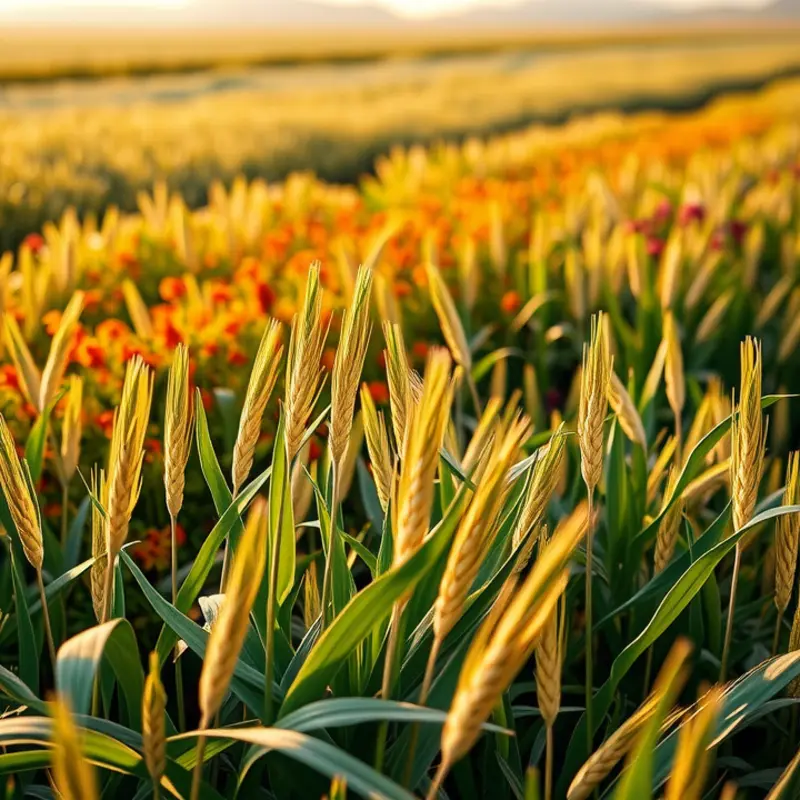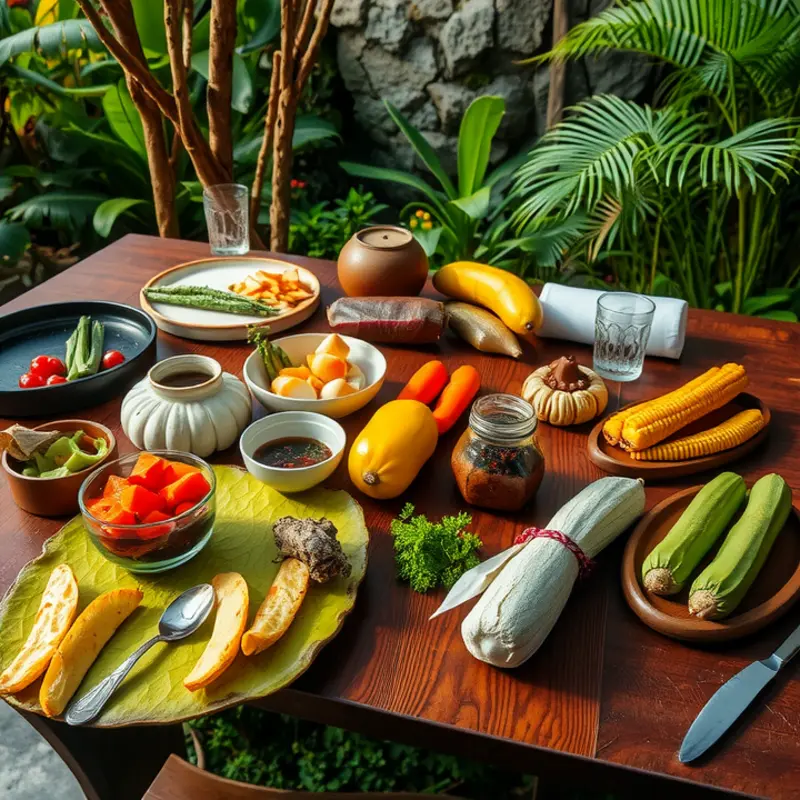Indigenous food heritage is a vibrant and essential part of global culinary traditions, reflecting the unique histories, philosophies, and environments of various cultures. These food practices not only sustain communities but also tell stories of resilience, adaptation, and respect for nature. As food enthusiasts and culturally-curious readers embark on this exploration, they will discover the rich tapestry of flavors, techniques, and ingredients passed down through generations. This journey honors the roots of our food systems and the harmonious relationships that Indigenous peoples maintain with their land.
The Heartbeat of the Land: Traditional Ingredients and Techniques

Across diverse indigenous communities, the relationship with the land is expressed through unique ingredients and culinary methods. This chapter explores various staples and techniques that reflect a deep connection with nature, shaped by local ecosystems and the environmental contexts in which they evolve.
In the Americas, corn holds a sacred place among many Indigenous peoples. Used in forms ranging from tortillas to tamales, corn is more than just sustenance; it embodies cultural identity and history. Cultivating corn involves centuries-old agricultural practices that respect land cycles, ensuring soil fertility while supporting biodiversity. The sustainable methods employed emphasize the importance of maintaining ecological balance.
Similarly, potatoes have been essential to the Andean diets. Indigenous farming techniques such as terracing allow for the adaptive use of land, preserving water and soil in challenging environments. These methods enhance food resilience, echoing a commitment to sustainability that resonates through generations.
In the Pacific Islands, foraging is integral to traditional diets. The rich biodiversity of the ocean and coastal areas provides ingredients like seaweed, which are rich in nutrients and flavor. Indigenous communities harvest seaweed using methods that ensure regeneration, a testament to their stewardship of marine environments. These practices intertwine with cultural rituals, recognizing the sea’s role in sustaining life.
In Australia, bush tucker—foods native to the land—forms the backbone of Aboriginal cuisines. Ingredients such as the macadamia nut or bush tomatoes are foraged with respect for the cycles of the land. Techniques passed down through generations include the use of earth ovens, firestick farming, and smoking, all contributing to seasonal rhythms that govern indigenous foodways.
For some Native American tribes, wild rice harvests are ceremonial events, blending cultural, spiritual, and ecological dimensions. The cultivation and preparation of wild rice are intertwined with natural cycles and community gatherings. Not only does this approach preserve knowledge, but it also honors the plant’s role in the ecosystem, ensuring its availability for future generations.
These culinary traditions highlight the cultural significance of each ingredient beyond its physical properties. Ingredients and their preparation methods reflect social connections, cultural values, and spiritual dimensions, providing a narrative into the community’s way of life. By embodying specific seasonal rhythms, these practices align foodways with natural cycles, promoting sustainability.
Exploring global indigenous food heritage offers profound insights into eco-smart kitchen storage practices. Adapting such diverse and sustainable techniques into modern kitchens underscores the importance of mindful consumption. Each culinary tradition, whether through the slow cooking of stews or fermentation of vegetables, teaches a timeless respect for nature’s abundance.
Through these culinary lenses, we gain a richer understanding of how indigenous peoples worldwide honor the land’s heartbeat. Their practices, rooted in the past, offer hope and direction for a sustainable future.
Stories on the Plate: The Cultural Significance of Indigenous Meals

In the rich tapestry of Indigenous cultures, meals often transcend the act of eating to become vibrant expressions of community and tradition. Indigenous cuisine is replete with rituals and customs that turn dining into a platform for storytelling and communal bonding. Every dish, ingredient, and technique carries with it stories of ancestors, cultural beliefs, and a deep connection to the land.
Take, for instance, the potlatch tradition practiced by the tribes of the Northwest Coast. A potlatch goes beyond being a feast; it is a ceremonial gathering that punctuates significant life events, such as marriages, births, and deaths. During the potlatch, the hosting family prepares an array of traditional foods from the sea, forest, and coast while guests share songs and tales passed down through generations. This tradition weaves together community ties, reinforcing social hierarchies and cementing alliances. Such gatherings are lively stages where oral histories and cultural identities are both preserved and celebrated.
Similarly, among the Plains Nations, communal feasting plays a crucial role. Buffalo hunts were not just about sustenance; they were communal endeavors that culminated in large feasts. Friends and families would come together to prepare and share meals, employing unique techniques like slow-cooking in earth ovens. Such meals were accompanied by dances, music, and storytelling. These communal activities strengthened community bonds and provided an opportunity to transmit cultural knowledge and social values to younger generations.
Traditional meals also serve as educational experiences, where knowledge about the land and sustainable practices are passed on. Indigenous cuisines are rich with ingredients that are foraged, grown, or hunted based on centuries-old sustainable methods. Young members of the community learn the importance of these methods as they participate in meal preparations. Learning details about plants used as flavor boosters without salt can enhance culinary practices rooted in Indigenous traditions. This approach not only sustains the environment but also fosters a sense of stewardship towards the Earth.
Moreover, the aesthetic presentation of traditional dishes often mirrors the landscapes and natural resources of the regions they hail from. The vibrant colors of corn in Pueblo cuisine or the intricate patterns on woven food baskets from Hopi tribes serve more than an artistic purpose; they are tangible links to the ancestral lands and histories.
Food is thus a powerful vehicle for identity among Indigenous peoples. The tastes, aromas, and rituals surrounding Indigenous meals create a sensory connection to forebears, allowing individuals to savor their cultural heritage with each bite. These meals are enduring testaments to the resilience and ingenuity of Indigenous communities, transforming the act of eating into an intricate dance of history, culture, and identity.
Ultimately, the communal experiences surrounding Indigenous meals remind us of the underlying narrative woven through humanity’s shared culinary journey. Exploring Indigenous food heritage teaches us to appreciate not just the flavor profiles but the rich stories that each dish carries, inviting us all to a deeper understanding of cultural identity and connection.
Final words
The exploration of Indigenous food heritage reveals rich stories intertwined with cultural identity, environmental stewardship, and time-honored traditions. Each dish and ingredient serves as a thread in the intricate tapestry of global cuisines, reminding us of the deep relationships Indigenous peoples maintain with their lands and ecosystems. As food enthusiasts and culturally-curious individuals, recognizing and appreciating these culinary traditions helps support sustainability and respect for cultural practices. By embracing these flavors and stories, we contribute to a more inclusive food narrative that honors diversity and heritage. Let the journey of discovery continue, pressing us to learn more about the food we consume and the cultures from which it originates.








